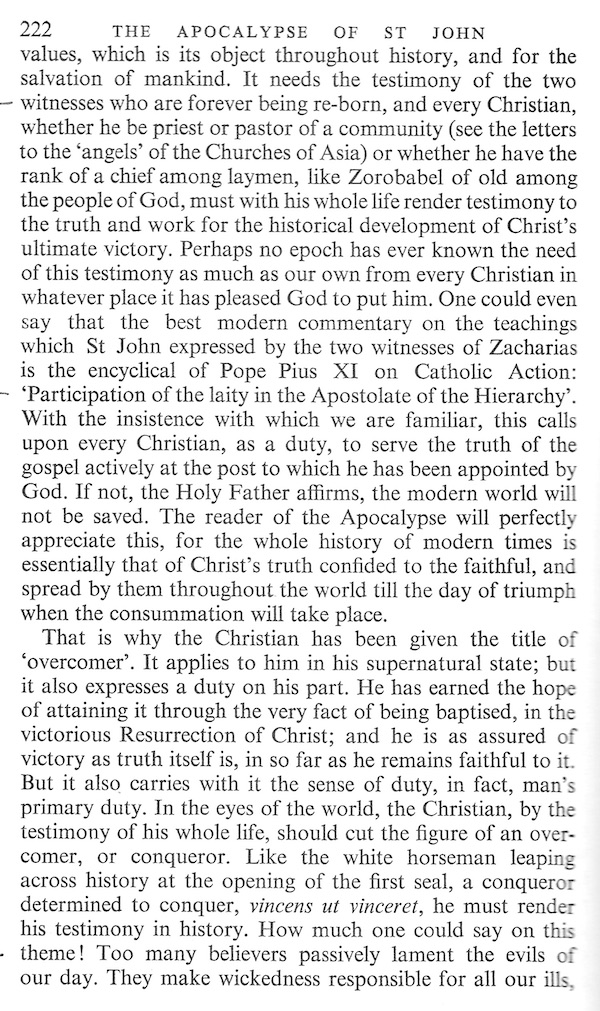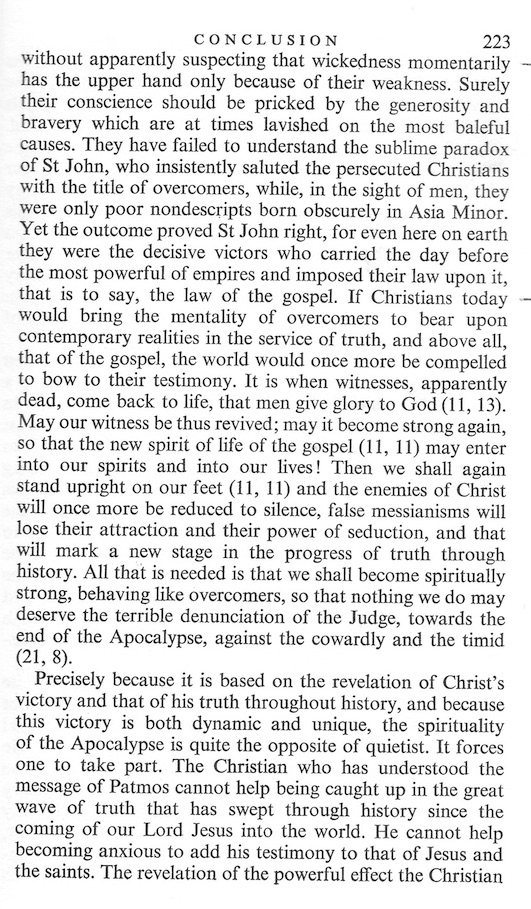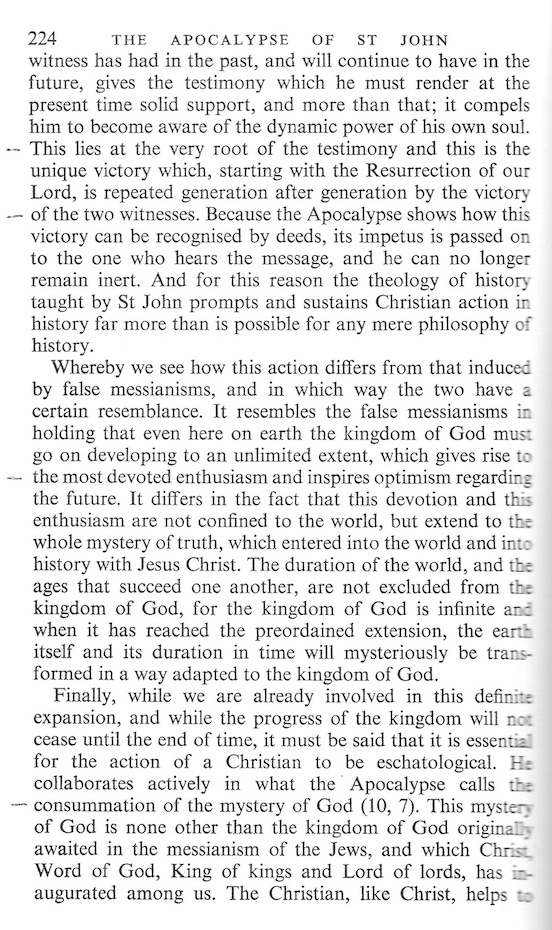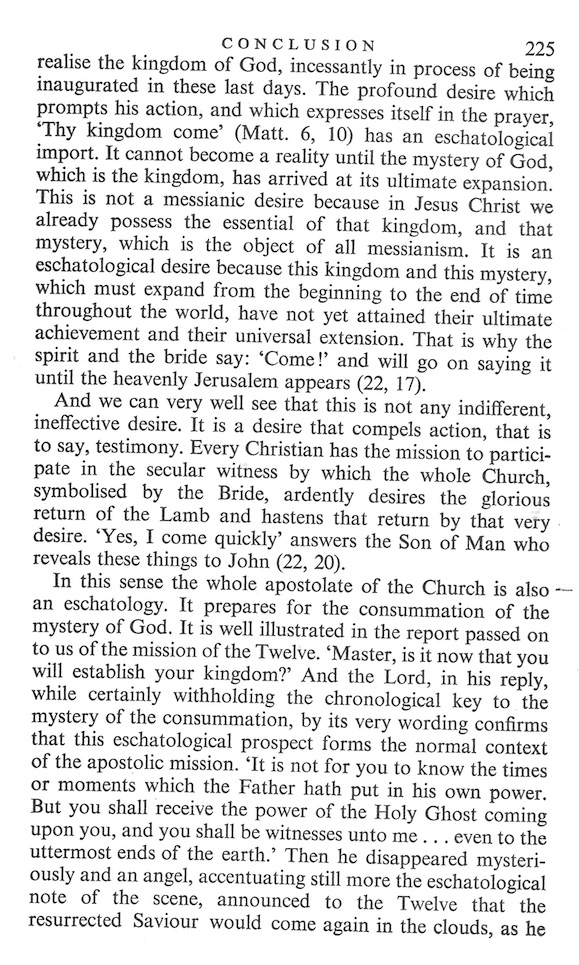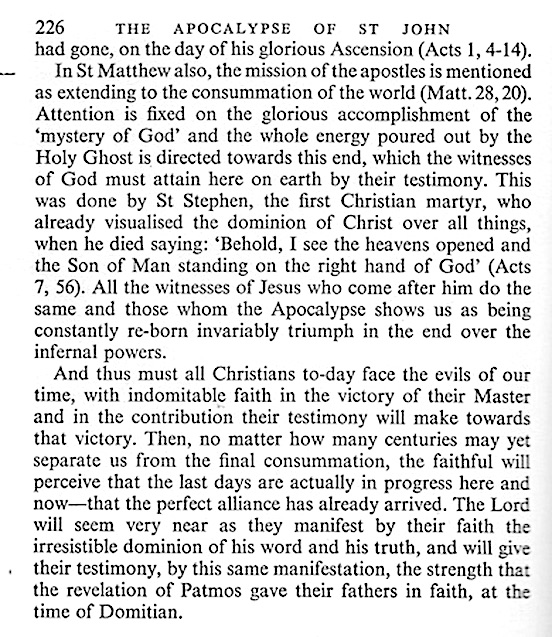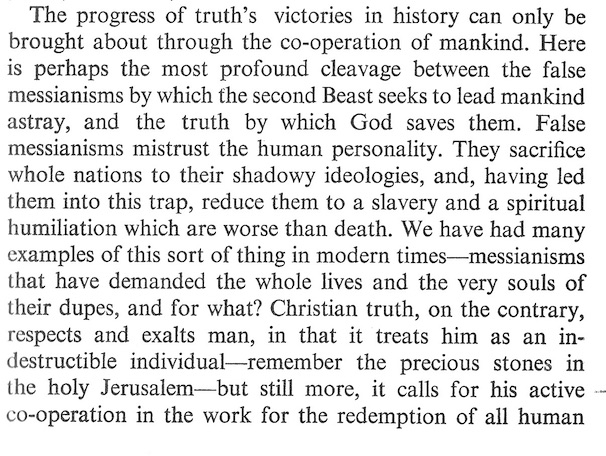
Our Place in Apocalyptic Time
+St. Catherine of Siena+
Introduction
Those who refuse to believe that the catacomb Catholic position could possibly be tenable frequently point to the course of the fulfillment of prophecy regarding the end times as justification for their rejection of this position. The commonly held belief, and we ourselves have not discounted it as possible, is that the papacy will be restored once Antichrist is defeated and the Church will triumph, if only briefly, prior to the Second Coming. But while Traditionalists base this on the totally false premise that we still have valid clergy who can provide the Mass and Sacraments, stay-at-home Catholics struggle to understand how the Church could ever be restored without a miracle directly from God; and, given the facts, they have every right to do so. Do we deserve such a miracle? No, although this does not mean that a merciful God would not grant us one if it was for His own glorification and that of the Church. Is such a thing likely? Certain Scripture passages seem to hint that it could happen, but God has kept the manner in which He intends to deal with these things a secret.
This is such a complicated and splintered subject, covering such a vast expanse of considerations, that any attempt to do it any justice would fail even if it ran to scores of pages. Yet there are some practical and to our mind unaddressed points and views that have not been considered when trying to piece together the entire puzzle of how everything we are seeing now relates to what Scriptural commentators and scholars have predicted for these times. Some would include here the private revelations of various saints and seers, but many of these seem only to further confuse and obscure any real appreciation of eschatology from a scriptural standpoint. The only exception to this is a scant few private revelations which seem to be in closer harmony with what is now occurring and those apparitions of the Blessed Virgin, which consistently recommend, prayer, penance and sacrifice. If we descend into the quagmire of attempting to make everything fit according to the vagaries of even the private revelation of the saints, we would be doing readers a disservice. Instead, while the Scriptures and teachings of certain theologians and commentators will be consulted, we will attempt to rely primarily on the few teachings provided by the popes on this matter, and what we ourselves now see before us.
The secrets of God and Antichrist’s reign
In surveying Holy Scripture alone, are we able to determine if these things have been fulfilled in our day? Well according to the commentators on Holy Scripture themselves, that depends. Rev. Hugh Pope, in his The Catholic Student’s Aids to the Bible, (Vol. 5, 1937) writes: “For the original hearers or pre-Christian readers of the prophecies of Isaias or Jeremias only one thing was certain: namely, that being divinely inspired prophecies, the things foretold would infallibly come to pass. But the time, place and manner of their fulfillment was hidden from them… To Christian readers or to non-Christian enquirers a flood of enlightenment regarding the prophecies was forthcoming in the New Testament fulfillment of the said prophecies… Since, then, the ultimate goal of the Apocalypse is the last things, full light will not be thrown on this prophetical book till those last things have received their ultimate fulfillment.” Rev. P. Huchede concurs, writing, “The events connected with the end of the world will alone remove the mystery in which the sacred text is at present enveloped.” Rev. E. S. Berry believes these prophecies “shall be understood in due time according to the needs of the Church” (The Apocalypse of St. John). But Berry emphasizes that the sealed book spoken of in Daniel 12: 4 and also the sealed book of the seven thunders in Apocalypse symbolizes that these prophecies would only be known when God chooses for them to be known. And it is clear that there is much we cannot and do not yet know about our current situation.
Everyone presumes that Antichrist will reign only three years and a half, and while this is designated as probable by some commentators and certain by others, it is misleading. No one has ever given a numerical value to the full term of Antichrist’s ENTIRE reign. St. Irenaeus teaches that “when this Antichrist shall have devastated all things in this world, he will reign for three years and six months…” Huchede says that it is not known how long it will take Antichrist to achieve the conquest of the world, although he assumes this will be a rapid process. Still, presumption must yield to fact. Gradualism was applied to good effect for decades prior to and long after Antichrist’s reign and acceptance as a true pope. Clearly the process of bringing about the level of devastation necessary for Antichrist to reign universally — not just in the Church but over the entire world — necessarily required an extended period of time, a process we have all witnessed firsthand.
If the Sacrifice was not to be abolished decades before the system of Antichrist matured sufficiently to assume full power, why did St. Thomas Aquinas envision a time when the world would think it had won because it continued to exist following Antichrist’s death? “Although men be terrified by the signs appearing about the judgment day, yet before those signs begin to appear, the wicked will think themselves to be in peace and security after the death of Antichrist and before the coming of Christ, seeing that the world is not at once destroyed as they thought hitherto,” (Summa Sup., 73:1). He doesn’t set a time limit for this occurrence. He couldn’t have made this statement believing that the Sacrifice could still exist after Antichrist’s death, knowing it was predicted to end at the time of his coming. It seems God would need to allow a relatively lengthy amount of time to elapse in order to put these wicked ones at ease and grant them the necessary time to perpetuate Antichrist’s system.
God’s time is not our time. And not all commentators agree that the three years and a half are to be interpreted literally. Rev. William G. Heidt O.S.B. tells us in his Book of the Apocalypse: “…three and a half years, 1,260 days, 42 months… [is] a proverbial number for a time of misfortune. Because of this proverbial usage the figures in question simply denote a period of distress, a period that may actually be quite short or one that could extend from Pentecost to the Parousia [Second Coming]. The emphasis is on misfortune, suffering, persecution, not on chronological duration.” Rev. Hugh Pope also writes: “St. John is not writing a continuous history of the Church’s future in chronological order…. There is no succession of time…” There is a notable absence of what Pope refers to as the “time note.” And he refers to a work by St. Methodius that was long ago lost which interprets the Apocalypse in purely allegorical (not literal) fashion, which means the three years and a half would be symbolic, not actual. Given what is said above about the exact fulfillment of these things it appears that none of this will really be known until the actual time the event occurs.
Some point out that there are problems with this opinion because it does not take into account the fact that the commentators teach the Mass will only be suspended for the three-and-a-half-year period during which Antichrist and also Enoch and Elias will make their appearance. But this is not really a problem that cannot be explained. Antichrist personally is the one designated to abolish the Sacrifice, no one else. Traditionalists unanimously agree that it was indeed abolished or abrogated by Paul 6 in April 1969. But few will tell you Paul 6 was Antichrist, although the Mass could not have been abrogated by anyone else. Witness the prefiguration of this in the Old Testament with the Jewish Antichrist Antiochus, aided by “the false high priest Menelaus…who obtained his position by usurpation and bribery” (Catholic Bible Dictionary, Rev. Bernard O’Reilly, L.D.). Menelaus was the equivalent of the false prophet in Ch. 13 of Apocalypse. Rev. Haydock says St. Jerome, the ultimate biblical authority, accommodated the person of Antiochus and applied him to Antichrist. Haydock notes Antiochus was “first despised and not received for king… [He] had no title to the crown, which he procured by cunning.” And as seen below, the title of Antichrist could refer to a king who reigns during an interregnum (Catholic Encyclopedia). The distinction must be made between Antichrist and his system and allowance must be given for the fact that while commentators assume the Man of Sin will rise rapidly to power, this has not been true in our case, however true it was in Jewish times. Nor has it ever been made clear by the commentators why they believe that the three and a half years equally applies to both the Jewish Antichrist and the Man of Sin.
Antichrist’s universal reign
Once Antichrist’s system has totally fulfilled its purpose and paved the way for the creation of a world government, then the final three-and-a-half-year period mentioned in the Apocalypse and in Daniel might possibly commence, and that could take place at any time now. It could come at the end of an extended reign of Antichrist, accomplished by those perpetuating his system. How can this be? We know from the article on Antichrist in the Catholic Encyclopedia that “one might interpret antichristos as denoting one resembling Christ in appearance and power,” which would lead us directly to Pope Paul IV’s definition of him as a man appearing to be the vicar of Christ but reigning only as a usurper. The encyclopedia article also says anti could refer to a king reigning during an interregnum or a hostile god and notes some believed Antichrist would overthrow the pope and usurp his see. It wasn’t just Paul 6 who fit this description, but each one of his successors as well. Chapter 13, verse 3 of Apocalypse refers to paganism revived in the opinion of several commentators, but it also could refer to the death and “rebirth” of succeeding usurper pontiffs. We know from Church teaching that each successor of St. Peter possesses exactly the same powers as St. Peter possessed, although they are not identical to St. Peter himself who first received the keys. If Antichrist strives to resemble Christ Himself as closely as possible, having received his keys from his father Satan, then the Father of Lies will likewise make certain that each successor of his appointed satanic pontiff will be vested with precisely the same title and powers as Antichrist himself. Could this transfer of power from Satan have been referred to by St. John?
“And the fifth angel sounded the trumpet, and I saw a star fall from heaven upon the earth, and there was given to him the key of the bottomless pit. And he opened the bottomless pit: and the smoke of the pit arose, as the smoke of a great furnace; and the sun and the air were darkened with the smoke of the pit” (Apocalypse 9: 1-2). It was Paul 6 himself who commented that the “smoke of Satan” had entered the Church. Being who he was, was he simply stating a fact? Berry says the star falling from heaven in this verse could be “any priest or bishop of the Church who becomes a leader of heresy… But in this case the star refers to some particular person whose revolt from the Church will lead directly to the reign of Antichrist.” The false prophet, who we believe to have been Angelo Roncalli (John 23), was most likely this falling star, for his appointment of Montini as cardinal, one of his first acts following his usurpation of the Holy See, led directly to Montini’s “papacy.” This is something that needs to be better understood because many have raised the objection that Roncalli and Montini could not have been the false prophet/Antichrist duo simply because Apocalypse says that these two men will be thrown alive into the lake of fire when Antichrist’s system is defeated. Roncalli and Montini created an entirely new religion over the span of a little over 10 years. This religious system survives until this day. What is destroyed in the end is not just these two men but their entire system, which passes on in all its fullness to each usurper and his personal false prophet (whatever person engineered his election or advancement or acted/acts as his personal assistant or secretary).
Think of it this way. If we said that the papacy itself was to be thrown alive into this same fire, as some Protestants believe, we would not limit that deliverance just to St. Peter and St. Paul, for example, for these are the men which it appears the false prophet and Antichrist are aping. We would include all popes from beginning to end, for this would be necessary to abolish the entire line of popes. It is no different with the system of Antichrist and the Satanic pontiffs. Whoever is reigning in Antichrist’s “see” at that time is the representative of the system he and the false prophet founded; they are all clones of the original — one and the same. They have continued the same teaching and furthered it, they have maintained and amplified the connections it takes to build this system and these connections go deep into the slimy underbelly of politics and high finance. Antichrist’s diabolical system financially influences world political interests in ways not completely known or understood. Various Vatican financial scandals, the dealings revealed by exposés regarding the Knights of Malta and other works, give us some idea of these connections. Vatican political dealings have been clearly leftist since the 1960s.
Doctrinal points regarding the Man of Sin
If we approach the problem from a doctrinal standpoint, Henry Cardinal Manning states that it was the unanimous opinion of the Fathers that the Holy Sacrifice would cease, and when the early Fathers speak on a subject regarding Holy Scripture, the Vatican Council teaches that this is to be considered a rule of faith. It also is certain according to nearly all Scripture scholars that Antichrist will be a specific individual. And Holy Scripture says he will cause the Sacrifice to cease. The infallible Scripture interpretation of Pope Paul IV in Cum ex Apostolatus Officio regarding the abomination of desolation has already been mentioned but bears repeating: Antichrist, which commentators equate with the abomination, will be a heretic invalidly elected pope and can be removed at any time. The pages on this website have been devoted to demonstrating that while Traditionalists may argue the Sacrifice has not ceased it most certainly cannot be said to continue at the hands of men whose orders are questionably valid and who therefore lack apostolic succession. They are simply the false prophets and false christs foretold in Holy Scripture. It is hard to see how the current situation is not the very one spoken of in Apocalypse 17, where the Babylonish whore rules from Rome, counterfeiting the sacrifice and sacraments as well as all of the rest of her operations; Antichrist continues to rule by proxy, spreading massive delusion with the aid of the operation of error; those keeping the faith have retired to the desert in the company of the Holy Ghost and Our Lady, which symbolizes a place of contemplation and the inability to receive the Sacraments.
Meanwhile, things continue to deteriorate at a rapid pace on the world stage, but lovers of solitude sheltered by Our Lady are not disturbed by this. For they know all this was preceded by what St. Paul prophesied — the mass exodus of bishops and priests from the Church, the Great Apostasy, at the time of the false Vatican 2 council, precisely when the Man of Sin was revealed to the world. We have seen these prophecies play out; what we cannot do is fit all of it to St. John’s vision of the Apocalypse. And this is not surprising, since God did not intend for us to know all the details of these things in advance. The important parts — the Great Apostasy, the cessation of the Sacrifice and the identification of the Man of Sin — he has given to us because we must know such things to save our souls. If there is to be a literal three-and a-half-year period and a reign of terror by those directing world government, in conjunction with a new world religion (a false pope playing out the role of high priest, while some political figure is set up, who, aided and abetted financially by Rome acts out the role of Antichrist) it will necessarily be accompanied by the coming of Enoch and Elias. This is another controversial point in question, and many have been asking for some time now, where are these two witnesses?
Where are Enoch and Elias?
Here we have a problem that has not been satisfactorily addressed, in this author’s estimation. We have a wide range of opinions on their appearance. St. Robert Bellarmine’s comments on this subject are important for many reasons.
“For it must be known that in the divine letters the Holy Ghost to have given as six sure signs concerning the coming of the antichrist: two which precede himself, namely: 1) the preaching of the gospel in the whole world and 2) the devastation of the Roman Empire; 3) the contemporaneous men (two witnesses) which it is to be seen prophesied Enoch (also called Henoch) and Elias (also called Elijah); 4) the greatest and last persecution and 5) that the public sacrifice (of the mass) shall completely cease; the two following signs 6) surely the death of the antichrist after three and a half years (after his rise to power) and the end of the world, none of which signs have we seen at this time. “The third demonstration arises from the coming of Enoch and Elias who live even now and shall live until they come to oppose Antichrist himself and to preserve the elect in the faith of Christ, and in the end shall convert the Jews and it is certain that this has not yet been fulfilled. But it is easily seen that… this is not a childish fantasy but a most true concept that Enoch and Elias shall personally return and it is also seen that the contrary concept (that they will not personally return) is either absolutely heretical or a serious error very close to heretical. The sixth demonstration arises from the last sign, that follows antichrist which shall be the consummation of the world. After antichrist at once comes the last Judgement … the future reign of antichrist shall be 1,290 days duration. Matthew 24: “This gospel of the kingdom shall be preached to the whole world and then shall come the consummation.” (Liber Tertius, p. 434-435). So according to St. Bellarmine, there will be no peace.
To summarize the above, the Gospel must be preached throughout the entire world, which, given the Church’s missionary efforts in her final days seems to have been achieved. However, Enoch and Elias renew this effort. Some would disagree, but commentators who were writing in the late 1800s or early 1900s could not have anticipated radio and television or increased access to remote areas. Next, it appears, comes the destruction of Rome. This must follow her already accomplished spiritual destruction. We will forgive St. Bellarmine for placing the cessation of the Mass before Enoch and Elias’ coming, for he does not indicate that these signs will take place in the order given. The order that seems to make sense for us is the following: 1) the preaching of the gospel in the whole world and 2) the devastation of the Roman Empire; 3) the greatest and last persecution 4) that the public sacrifice (of the mass) shall completely cease; the two following signs 5) the contemporaneous men (two witnesses) which it is to be seen prophesied Enoch (also called Henoch) and Elias (also called Elijah); and 6) the death of the antichrist after three and a half years (after his rise to power).”
So if we fit this to our own times, it is possible these two prophets could appear in the near future. At least according to Bellarmine, St. Ephraem, St. Hippolytus and others. One commentator (Ratton) claims they have already come, (before the destruction of the Jewish Temple in A.D. 70). Rev Leo Haydock comments that “…Allowing it a received opinion that Henoch and Elias are again to come before the day of judgment, yet it is not the constant doctrine of the ancient fathers, that by these two witnesses in this place of the Apocalypse, must be understood Henoch and Elias. St. Cyprian expounds it of two sorts of martyrs for the Catholic faith; to wit, they who suffer death, and others who only suffered imprisonment, loss of goods, and the like. Others expound it of the testimonies concerning Christ and his Church, of which some are in the Old Testament, some in the New. To these we must join all those interpreters who expound all the visions and predictions in the Apocalypse, till the 20th chapter, of the persecutions raised by the Jews: or by the heathens against the Church, which have already happened …Two witnesses. It is commonly understood of Henoch and Elias. (Challoner).” Another commentator suggests that the witnesses were Pope Pius IX and Pope St. Pius X, who warned in one of his first encyclicals that Antichrist already had been born in 1903. So no one is united in their views on this interpretation
A brief peace, or the consummation?
Given the current political situation both here and abroad, it would seem that we are closer to the realization of a worldwide government and religion than at any other time in history. The times are approaching when everything may utterly collapse. As out there as this may sound, the only hope of the peace everyone seems to expect could be the arrival of Enoch and Elias, designated to battle Antichrist and his system. We cannot discount Fatima, La Salette and other indicators of this peace, but they certainly cannot be considered in the same light as the theologians, the popes and Holy Scripture itself. Holy Scripture tells us these two prophets will be two candlesticks and olive trees in Apoc. 11: 4, possessing the gift of miracles, and the symbolism used in Apocalypse to describe them indicates they could possibly be vested with episcopal orders. Rev. James L. Meagher, D.D. (How Christ Said the First Mass, 1906) explains that the removal of the candlesticks in Apoc. 2: 5, refers to the Jewish Holy of Holies, “emblematic of Christ the Light of His Church…[and] also foretold the bishop, light of his diocese… The Son of God told John, His beloved Apostle to write to the seven churches of Asia that if they did not do penance he would remove their candlesticks — that is, their bishops.” Commenting on this same verse, Rev. E. S. Berry also mentions a candlestick and its removal, which he says refers to a particular Church. According to Berry, bishops are referred to as stars or angels in Apocalypse, but by extension the removal of an entire church would also mean removal of its bishop.
Since olive oil is used to consecrate bishops, one must wonder if this has any significance regarding their episcopal status. Miracles alone would prove their jurisdiction. Berry calls them “apostles” and Rev. Robert Eaton says in his The Apocalypse of St. John (1930) that the “olive trees and candlesticks (verse 4) speak of the priesthood and kingship of Our Lord.” In his The Book of Destiny, Rev. H.B. Kramer notes: “The olive tree is the symbol of God’s mercy and the oil is the threefold office of prophet, priest and king.” These two men may appear when Antichrist’s system begins its complete and universal reign which could then last for three years and a half. The commentators say these two witnesses will “restore all things.” Kramer refers Apoc.11:3 to the prophecy of Zacharias 4:14, making Jesus son of Josedech and Zorababel types of the two witnesses. Following the Babylon Captivity, “these two restored the theocracy.” During the Babylonian Captivity, the Jews were held captive anywhere form 48-70 years. In October of 2021, the Church will have been held captive by the Roman usurpers for 63 years.
Three scenarios are possible here if these two witnesses are to come at this time. First, Enoch and Elias will come to restore the papacy and convert the Jews. Physical Rome will probably be destroyed, having already been decimated spiritually, and Antichrist will proceed to Jerusalem. Antichrist and his system win a monumental battle in Jerusalem, seizes the two witnesses and puts them to death. The witnesses rise after three days and finally enter heaven. Eventually Antichrist and his entire army are destroyed by the Archangel St. Michael or some other entity and are literally thrown into a lake of fire. A literal three days of darkness might ensue and the brief period of peace and restoration of the Church would follow. Or, after Antichrist’s system is defeated, the end could come immediately. Commentators simply do not agree. If those commentators who believe that the two witnesses will not come in person are correct, and this does not seem to be the case, the end could come at any time. But given the fact that there is no other valid way to restore the papacy other than by a true bishop(s) who would create other bishops to canonically elect a true pope, only the arrival of Enoch and Elias could result in the peace so many are anticipating.
What are Catholics to believe?
First of all, it seems only logical to conclude that we are to pray and watch; to read and understand. These are the repeated messages for the end times in Apocalypse and the Gospels and Epistles regarding the Last Days. The focus should be on our own spiritual lives and the preparation we must all make to remain Catholic in a world gone mad. Prayer and penance are the only remedies for what we face today. We will know Enoch and Elias when they come for as champions of the law, they will be no friends of the Traditionalists and will preach consistent with those dogmas of faith that existed prior to the death of Pope Pius XII. They will also likely cast some reproaches at the lukewarm among stay-at-home Catholics. No one can be certain how these prophecies of the Apocalypse will be fulfilled; it is God’s secret alone. That is why we are told to pray and watch, for He did give us certain indicators of the more significant events, enumerated above by St. Bellarmine. Before leaving this subject, we add a few pages written by one commentator about the two witnesses and what it means to really be a witness. These excerpts are taken from The Apocalypse Explained, written by H.M. Feret in 1958. They are a reminder that when these two great men arrive, they will necessarily create a following and will expect to be joined by those who keep the true faith of Christ. We are not meant to be led by them, but to lead with them. Catholics who for years have been awaiting a savior on a white horse may be surprised to learn here that they were intended all along to be the army that leads that charge to victory.

